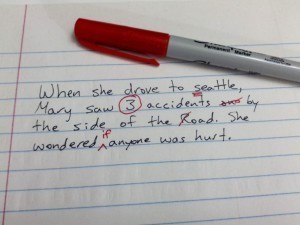My Process for Approaching Large Revisions
By Elizabeth S. Craig, @elizabethscraig
 I received an email last week from a writer who is feeling a little overwhelmed by the revision process and asked if I’d written any posts that helped to sort of sort through revision in an organized way.
I received an email last week from a writer who is feeling a little overwhelmed by the revision process and asked if I’d written any posts that helped to sort of sort through revision in an organized way.
And my first reaction was, besides completely understanding why anyone would feel overwhelmed, was: “Oh sure, I’ve got gobs of blog posts like that.” But…no. Although I talk a lot about my need for revision and stuff I’ve had to fix in the past, and the fact that I don’t edit while I draft–I had no posts at all about how I organize and approach revision. So I’ll correct that now. And, looking at my process below, I’m thinking that one reason I might not have outlined this before is because it so closely resembles my process for writing a book that maybe I thought I’d repeat myself.
This is a process for someone who really, really needs a process or has become frozen because there is so much to do and she doesn’t know where to start. It could work for someone with really limited time and a demanding day job. Or someone who has tried other methods without success.
First off:
Brainstorm a list for your revision.
This may be a humdinger of a list, but work on it a little every day. Maybe you already have a list of notes to yourself about manuscript problems…this is a good time to organize the bits into a master list.
Everything goes on the list. The stuff you worried about in your book. The feedback you got from your editor/beta reader/critique group. It’s a master list.
Brainstorm all the global problems you recognize in your book. You might know immediately what these are. If you can’t put your finger on them, think about lack of conflict, whether the protagonist is taking charge or observing, character development, character growth, flat dialogue, and character goals/motivation.
Brainstorm all the smaller mistakes you want to watch for. Be thinking about things like: repeated words (echoes), continuity errors (character’s hair color/outfit changes in same scene), POV problems, pacing (some scenes too rushed? some scenes too slow?) too many adjectives or adverbs, dialogue tag issues, varied sentence structure, bumpy scene transitions, etc. Weak word choice–sometimes I’ll double-check that I’ve used words like felt, very, look, started to, think, really, put in a smart way.
Brainstorm all the additions you want to make to the manuscript. These might be chapter breaks, descriptions, setting description, added scenes that add conflict or develop character, etc.
Brainstorm all the deletions you know you want to make to the manuscript. These might be instances of backstory, dull dialogue, or meandering scenes that don’t further the story.
Then: break headings on your list into smaller tasks of things to do/address. See how many tasks you can break each area down into. So maybe you received some beta reader/editor/crit group feedback: Help make main character more sympathetic and likeable. You could change that to add in a pet-the-dog/save the cat moment near book’s beginning.
Martin seems too flat as a character could have a few to-dos: Brainstorm Martin’s backstory and what he fears most/wants most. List why Martin is important to the protagonist and ways to make him more so. How does Martin grow during the story?
Some of these things are going to take only a few minutes (word searches for frequently repeated words or potential problem words). Some will take longer (continuity errors, POV, etc.). If you’ve broken down some of your bigger tasks into much smaller, manageable to-dos, though, you’ll have bits you can accomplish even in small amounts of time.
After you finish with your list, work on it as you have time. If you’re forgetful like I am, carefully mark off each item when you’ve finished. Mark on your document where you left off, if you’re working on a read-through. I use Word’s Track Changes or Comments feature.
Continuity errors seem to take the longest amount of time for me to catch because I usually have to jot down notes about what day of the week the story is on, a character’s eye color (can prevent this if I make a style sheet as I write the book!), etc. Read through the book for continuity errors (notepad beside us), POV, and transition problems.
If you come across additional problems as you go, add them to your to-do list, also breaking them down into smaller tasks.
Double-check yourself. Check your list again.
Do a final read-through to make sure all your deletions, additions, and word changes make sense.
Call yourself done and reward yourself somehow. Maybe by starting on that next book that was tempting you the whole time you were plodding through your revision?
I’ll add here that now, although I still do need a list to help me keep track of changes I need to make, I don’t *have* to make one as extensive as the one above…now it’s more rote because I’ve done it so many times. This is more if you have a heckuva revision on your hands, feel overwhelmed, or need to apply some real organization to your project to help stay on track and motivated.
There are so many ways to approach a big revision. What are some of your tips?
Image: MorgueFile: jppi
The post My Process for Approaching Large Revisions appeared first on Elizabeth Spann Craig.



